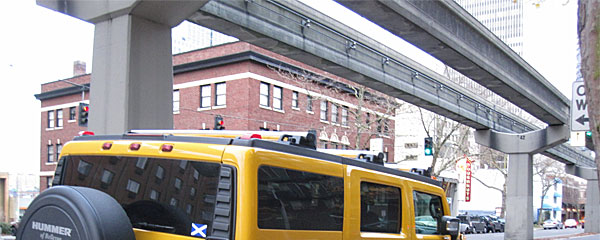
I’m still trying to get a handle on the mess of disjointed reasoning that stands in for transportation policy in Seattle, so Knute Berger’s paean to some unused offramps for an expressway that never got built is actually really instructive. It’s also kind of nuts.
My first reaction to the piece, which describes the “Ramps to Nowhere” as a symbolic reminder of a time when Seattlites came together and blocked a massive ring road, was that it’s kind of telling when you measure your city’s history of urbanism by the infrastructure projects you’ve blocked instead of the ones you’ve built. My second was that if you’re looking for monuments to Seattle’s urbanist heyday, you really don’t need to go all the way up to 520; there’s a much better one cutting straight through downtown. And you can even ride on it!
From what I can gather, the problem with the R.H. Thompson Expressway—the never-built road for which the Ramps to Nowhere were made—was that it would have cut through a bunch of neighborhoods and turned the city into a car-clogged nightmare, which sounds a lot like what I-5 has done anyway. The main result of the expressway’s defeat seems to be that Seattle doesn’t have a decent east-west arterial, so driving the three miles between the University District and Ballard can be only marginally faster than walking.
If Seattle had a robust public-transportation system, that would be fine. Instead, the city has about six different half-realized transit programs that seem designed to be as confusing and awkward to use as possible. There’s a bus rapid transit system with too few buses and too many stops to actually be rapid, a light-rail system that works great if you live between downtown and the airport, a streetcar that’s nice if you live between downtown and Lake Union, and a standard bus system that seems to have a chronic aversion to route maps. Plus the water taxi.
My favorite example, though, is the monorail, which has exactly two stops, doesn’t connect to any other transit system, and mostly exists to look cool and make changing lanes on 5th Avenue almost impossible.
Don’t get me wrong: I love the monorail. But it was built as a gimmick for the World’s Fair, and the city could never be bothered to expand it into a real public transportation system, despite some obvious interest from the public.
If Seattle’s urbanists could channel the same energy they spend freaking out over every new road project into a decent unified transit strategy, the city would be a lot better for it. But the history seems to point less to a tradition of rejecting misguided transportation projects than a tradition of rejecting every transportation project, usually after several years of development. The city has to reconcile a host of competing utopian visions of what Seattle ought to look like, and ends up trying to do everything but doing nothing very well.